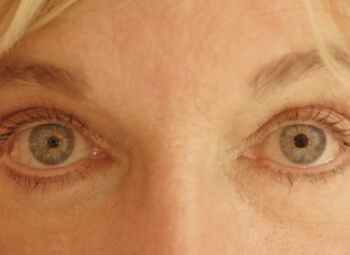
Plop. There they’d go again, reading glasses sliding off the ski jump of my nose. I’d push them back—that is, when I could find the darned things. Losing my near or up-close vision was one of the first thunderclaps announcing: “You are not 20 anymore, girlfriend.” I mean, I’d always had 20/20 vision, until I, like millions of others, turned 50. Then I got the “fuzzies.”
Most of us will develop presbyopia, in which the crystalline lens of the eye loses its flexibility. For boomers, this may sound all too familiar: losing flexibility, that is. Good news! Symptoms of presbyopia can be improved without wayward specs or contact lenses. My contacts frequently flew across the room to be lost forever.
It was meant to be that in late 2009, I’d coincidentally hear about the AcuFocus™ Corneal Inlay Clinical Research Study being conducted in—among other locations—nearby Irvine, Calif., at the former TLC Laser Centers, now called “NVision.” The respected Dr. Thomas Tooma is in residence there, acknowledged as a world pioneer in LASIK and having performed more than 150,000 procedures, including 250 procedures on fellow eye doctors. He oversaw my inlay procedure.
The Next Big Eye Thing?
Testing a new technology that might improve my functional near vision and reduce dependence on reading glasses with minimal side effects did sound extraordinarily tempting. So after rigorous diagnostics to evaluate my qualifications as a candidate, I passed the exams. Early in 2010, I underwent the no cost, investigational procedure.
Sure, the idea of having anything inserted into my eyeball made me quiver. Yes, I was very nervous. With the help of a prescribed Xanax® and numbing eye drops, all I recalled post-procedure were red lights in my field of vision: no pain, no real discomfort. I am one of those “highly sensitive persons” and this was a breeze.
My inlay—not an implantable lens—successfully altered the way light enters my eye: Think “photography” and “aperture.” The inlay blends “just so” with my eye’s surface and a huge plus is that it’s removable. The surgery occurred within my cornea—although nothing was removed.
In the past, presbyopia was treated with just Monovision LASIK so that one eye was corrected for distance and one eye was corrected for near vision.
I’ll Keep It
How does it look? It’s a black ring with a tiny hole in the center. It’s smaller than a contact lens and is comprised of “biocompatible” material meant to function in intimate contact with living tissue. The inlay is 3.8 millimeters in diameter and only 10 microns thick, or 1/10 the thickness of a sheet of paper.
My left pupil does appear slightly larger than my right. A friend kidded me at first about looking a bit like “an alien,” but she’s never seen an alien. (Have you?) No one really notices now. Not even me, unless I look closely at me with my new-and-improved eyesight. I may be encountering some issues with depth perception, as evidenced by random bumps on my head and elbows.
Did it work? Yes. I can see up close without glasses and I retained my distance vision. Would I do it again? Yes. Stand by, for several other variations on this theme are currently being tested. Perhaps there’s a study coming to a neighborhood near you. If all goes well, you and others might have an improved procedure done commercially in three to five years. Nearly 1.5 billion people worldwide need reading glasses.
See ya’! (Because now I really can.)